Smaller asteroids may pose greater danger than previously believed
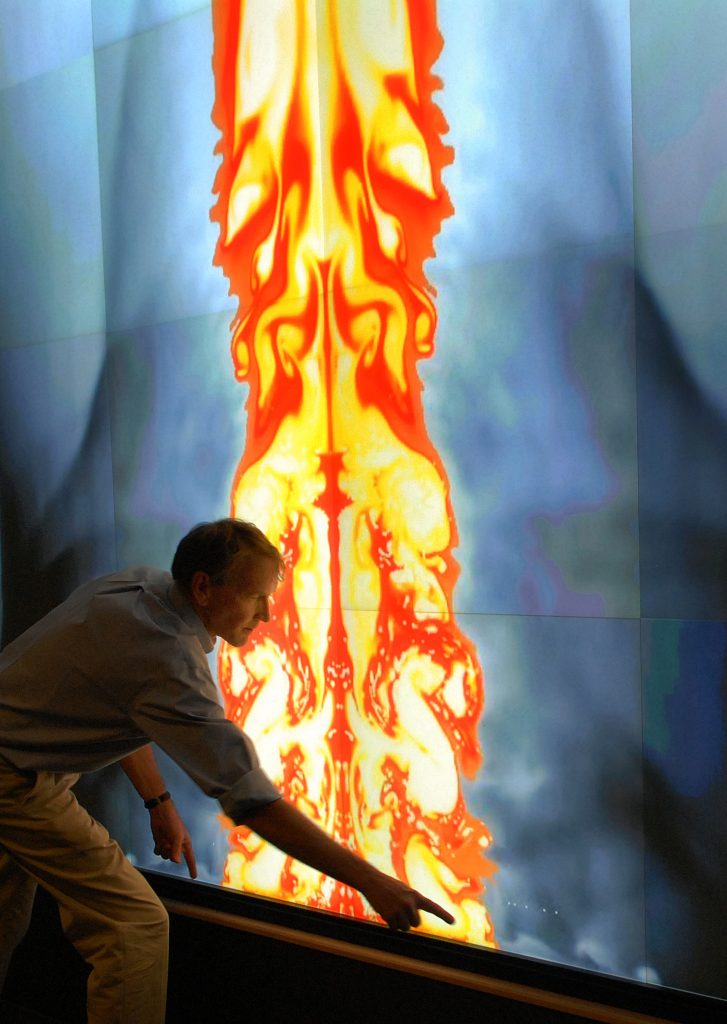
ALBUQUERQUE, N.M. — The stunning amount of forest devastation at Tunguska a century ago in Siberia may have been caused by an asteroid only a fraction as large as previously published estimates, Sandia National Laboratories supercomputer simulations suggest.
“The asteroid that caused the extensive damage was much smaller than we had thought,” says Sandia principal investigator Mark Boslough of the impact that occurred June 30, 1908. “That such a small object can do this kind of destruction suggests that smaller asteroids are something to consider. Their smaller size indicates such collisions are not as improbable as we had believed.”
Because smaller asteroids approach Earth statistically more frequently than larger ones, he says, “We should be making more efforts at detecting the smaller ones than we have till now.”
The new simulation — which more closely matches the widely known facts of destruction than earlier models — shows that the center of mass of an asteroid exploding above the ground is transported downward at speeds faster than sound. It takes the form of a high-temperature jet of expanding gas called a fireball.
This causes stronger blast waves and thermal radiation pulses at the surface than would be predicted by an explosion limited to the height at which the blast was initiated.
“Our understanding was oversimplified,” says Boslough, “We no longer have to make the same simplifying assumptions, because present-day supercomputers allow us to do things with high resolution in 3-D. Everything gets clearer as you look at things with more refined tools.”
Sandia is a National Nuclear Security Administration laboratory.
The new interpretation also accounts for the fact that winds were amplified above ridgelines where trees tended to be blown down, and that the forest at the time of the explosion, according to foresters, was not healthy. Thus previous scientific estimates had overstated the devastation caused by the asteroid, since topographic and ecologic factors contributing to the result had not been taken into account.
“There’s actually less devastation than previously thought,” says Boslough, “but it was caused by a far smaller asteroid. Unfortunately, it’s not a complete wash in terms of the potential hazard, because there are more smaller asteroids than larger ones.”
Boslough and colleagues achieved fame more than a decade ago by accurately predicting that that the fireball caused by the intersection of the comet Shoemaker-Levy 9 with Jupiter would be observable from Earth.
Simulations show that the material of an incoming asteroid is compressed by the increasing resistance of Earth’s atmosphere. As it penetrates deeper, the more and more resistant atmospheric wall causes it to explode as an airburst that precipitates the downward flow of heated gas.
Because of the additional energy transported toward the surface by the fireball, what scientists had thought to be an explosion between 10 and 20 megatons was more likely only three to five megatons. The physical size of the asteroid, says Boslough, depends upon its speed and whether it is porous or nonporous, icy or waterless, and other material characteristics.
“Any strategy for defense or deflection should take into consideration this revised understanding of the mechanism of explosion,” says Boslough.
One of most prominent papers in estimating frequency of impact was published five years ago in Nature by Sandia researcher Dick Spalding and his colleagues, from satellite data on explosions in atmosphere. “They can count those events and estimate frequencies of arrival through probabilistic arguments,” says Boslough.
The work was presented at the American Geophysical Union meeting in San Francisco on Dec. 11. A paper on the phenomenon, co-authored by Sandia researcher Dave Crawford and entitled “Low–altitude airbursts and the impact threat” has been accepted for publication in the International Journal of Impact Engineering.
The research was paid for by Sandia’s Laboratory-Directed Research and Development office.
Movie Clips
The following clips are available for viewing.
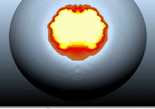 | Movie 4 (11.4 MB) A 62 thousand ton stationary asteroid explodes with an energy of 5 megatons at 5 km above the surface. The movie window is 15 km wide and about 8 km high. Bright colors of the fireball indicate temperature, ranging from steam (dull red) to rock vapor (white). Gray background indicates air density and shows a spherical blast wave that reflects from the ground. The fireball rises buoyantly and cools as it recedes, limiting the thermal effects on the surface. This simulation shows what happens when momentum is ignored to simplify the problem as scientists have done in the past. The airburst is approximated by a “point source” explosion similar to a nuclear detonation. |
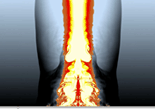 | Movie 1 (11.4 MB) This simulation shows what happens when momentum is not ignored, an approach that is allowed with modern supercomputers and codes. The same asteroid is now moving through the atmosphere at a typical impact velocity (20 km/s). For illustration purposes, extra energy is deposited into the asteroid when it reaches 5 km, for a total of 5 megatons. Momentum carries the hot fireball down to the surface, which enhances heat and wind effects on the ground. |
 | Movie 8 (9.8 MB) Close-up of the previous simulation. The box dimensions are 4 km wide and 3 km high. The colors indicate the energy associated with vorticity, the swirling, tornado-like eddies generated by the downward motion. High velocity winds can be sustained at ground level by vortex flow. |
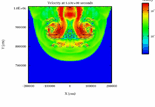 | Movie 7 (5.3 MB) Tracking of 5 megaton asteriod that begins exploding at 20 km above the surface, but carries its energy down to about 8 km. Axes are labeled in cm, and colors indicate velocity in cm/s. |
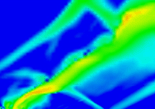 | Movie 3 (4.8 MB) 3D simulation of a 15 megaton explosion that is initiated 18 km above the surface, for an asteroid entering at an angle of 35 degrees above the horizontal. Box dimensions are 40 km wide, 20 km high. Colors indicate speed. The hot fireball decends to the surface and slides downrange at high velocities, subjecting the landscape to blast-furnace condtions. This did not happen at Tunguska. |
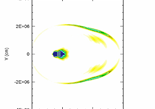 | Movie 5 (4.2 MB) Map view of blast zone from 3-D simulation of a 15 megaton explosion. Axes are labeled in centimeters, and colors indicate wind speed. Expanding oblong shape is the blast wave moving along the surface, blowing down trees with wind speeds decreasing from high hurricane force of 60 m/s (magenta) to below 20 m/s (yellow). Blast-furnace conditions are sustained downrange (left) of the origin where the fireball contacted the surface. This did not happen at Tunguska, so the asteroid must have been smaller (less energetic). |
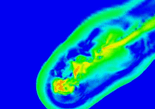 | Movie 2 (4.8 MB) 3D simulation of a 5 megaton explosion that is initiated 12 km above the surface, for an asteroid entering at an angle of 35 degrees above the horizontal. Box dimensions are 40 km wide, 20 km high. Colors indicate speed. The hot fireball does not reach the surface, but descends to an altitude of 5 km before buoyantly rising. At ground zero, the blast wave comes from directly above, consistent with observations of standing trees at the Tunguska epicenter. |
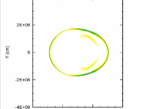 | Movie 6 (3.4 MB) Map view of blast zone from 3-D simulation of a 5 megaton explosion. Axes are labeled in centimeters, and colors indicate wind speed. Expanding oblong shape is the blast wave moving along the surface, blowing down trees with wind speeds decreasing from high hurricane force of 60 m/s (magenta) to below 20 m/s (yellow). Because the fireball stops at high altitude, there is no blast furnace zone near the epicenter and trees remain standing as observed at Tunugska. |
